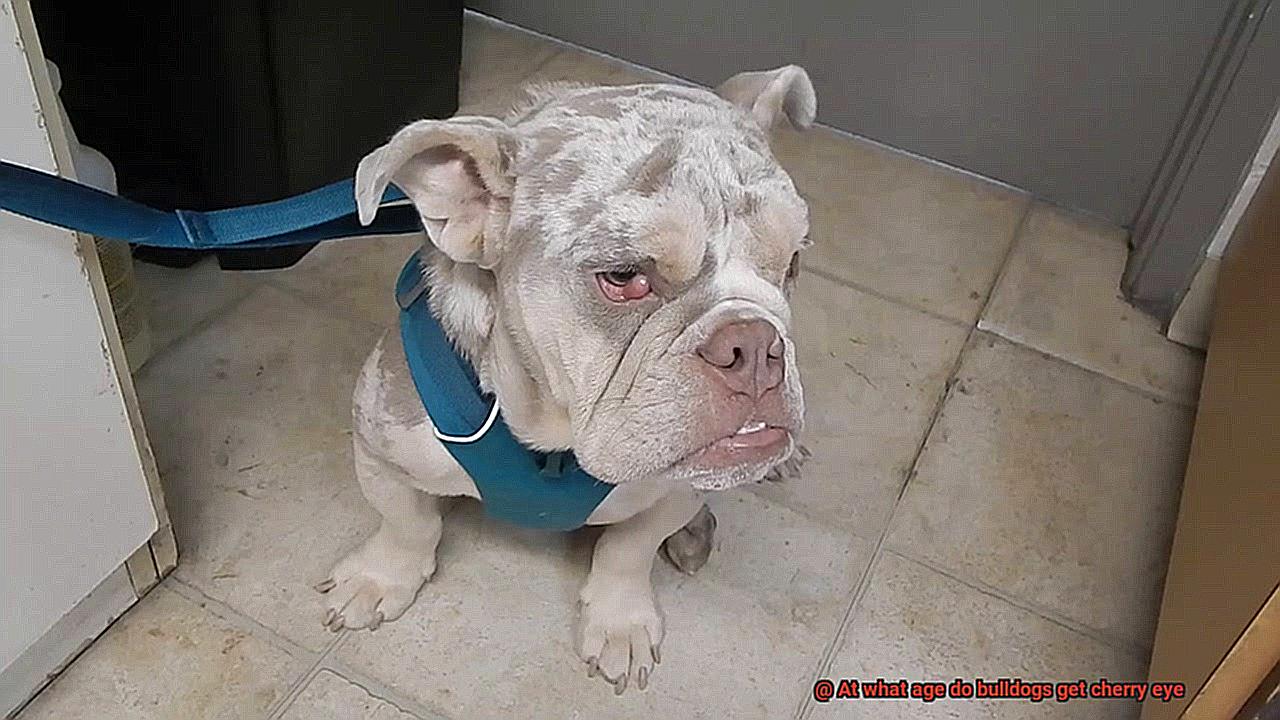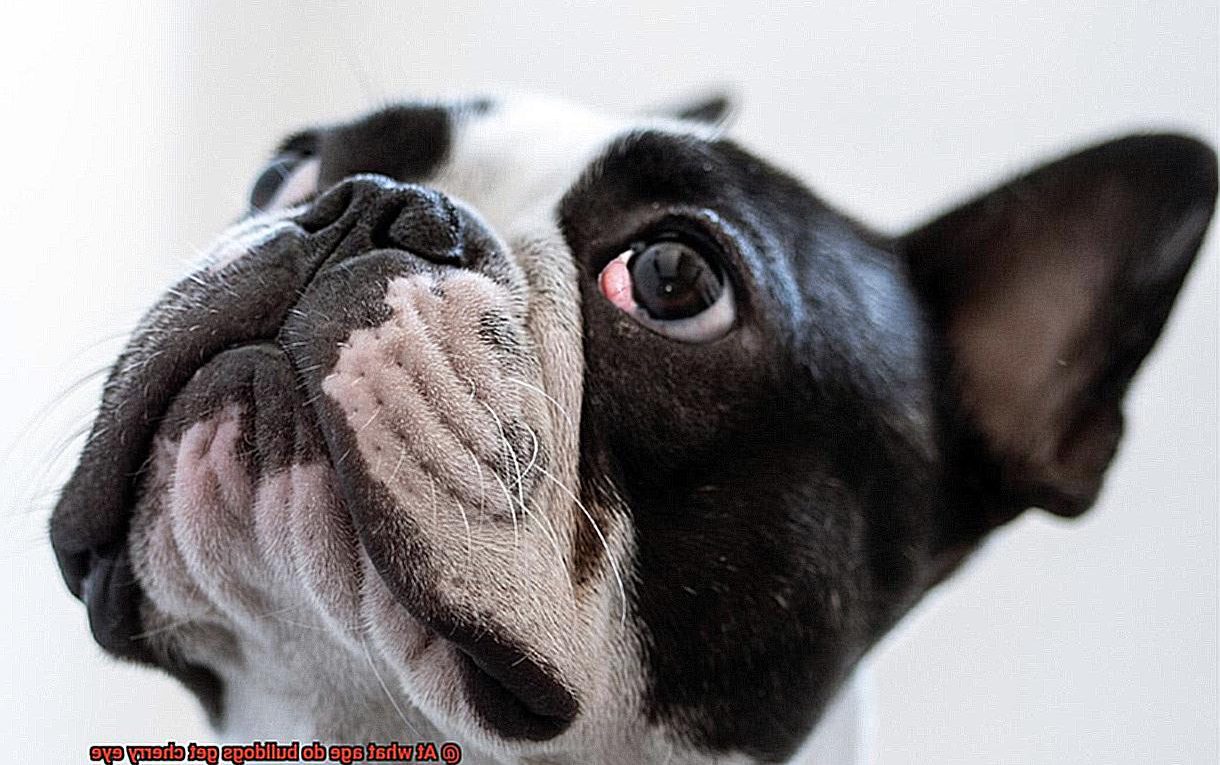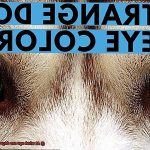At what age do bulldogs get cherry eye?
You’re thinking about bringing a lovable bulldog into your life? Well, buckle up, because it’s time to delve into the world of potential health hiccups that may come with those adorable wrinkles. One issue that often pops up (literally) is cherry eye. Now, you may have heard whispers about this peculiar condition, but when exactly does it make its grand entrance in the lives of our wrinkly-faced friends? Today, we’re here to spill the beans and shed some light on the age at which Bulldogs typically find themselves dealing with cherry eye.
Cherry eye, or as fancy scientists call it – prolapse of the nictitating membrane – happens when that little gland responsible for producing tears decides to go rogue and pop out for all to see. While any dog can be affected by this ailment, Bulldogs have a special knack for it due to their genetic predisposition. But don’t fret. Knowing when this trouble tends to strike allows us to catch it early and take action.
Usually, bulldogs start experiencing cherry eye between six weeks and two years old. Now, I know what you’re thinking – “That’s quite a big range.” And you’re right. Each bulldog is unique and might have their own timeline. But during this period, it’s vital to keep a close watch on those precious peepers.
Hold onto your hats because we’re about to dive deeper into the causes, symptoms, treatment options, and even prevention strategies linked with cherry eye in bulldogs. Armed with knowledge like this, you’ll be able to ensure your beloved bulldog buddy stays happy and healthy while steering clear of any pesky eye-related troubles.
Stay tuned as we embark on this journey together.
At what age do bulldogs get cherry eye
Contents
- 1 At what age do bulldogs get cherry eye
- 2 What Causes Cherry Eye in Bulldogs?
- 3 At What Age Do Bulldogs Get Cherry Eye?
- 4 How to Spot the Signs of Cherry Eye in Bulldogs
- 5 How is Cherry Eye Diagnosed in Bulldogs?
- 6 Treating and Preventing Cherry Eye in Bulldogs
- 7 The Importance of Early Detection and Treatment for Bulldog’s Cherry Eye
- 8 Common Complications of Untreated Cherry Eye in Bulldogs
- 9 Tips for Caring for a Bulldog with Cherry Eye
- 10 Conclusion
If you’re the proud owner of a French Bulldog, you may have heard about a condition called cherry eye. As a responsible pet parent, it’s essential to understand this common eye disorder and its impact on your furry friend’s health. In this article, we’ll explore at what age bulldogs are most likely to develop cherry eye and discuss the importance of early detection and treatment.
The Age Range for Cherry Eye:
Cherry eye can affect bulldogs of all ages, but it is most commonly seen in puppies between 6 weeks and 9 months old. During this period, the connective tissues that support the gland responsible for cherry eye are not fully developed, making puppies more susceptible to this condition. However, older bulldogs can also develop cherry eye, so it’s crucial to remain vigilant throughout their lives.

Genetics and Environmental Factors:
While the exact cause of cherry eye in bulldogs is not fully understood, genetics and weak connective tissues are believed to play a significant role. If your bulldog has a family history of cherry eye, they may have an increased risk of developing the condition. Additionally, certain environmental factors such as allergens or irritants can contribute to the development of cherry eye.
Signs and Symptoms:
Detecting cherry eye early is key to successful treatment. Keep an eye out for symptoms such as redness, swelling, discharge, and discomfort in your bulldog’s affected eye. If you notice excessive rubbing or scratching, it’s essential to consult your veterinarian promptly.
Treatment Options:
When it comes to treating cherry eye in bulldogs, there are both medical and surgical options available. Your veterinarian may initially try conservative management, which involves using ointments or drops to reduce inflammation and manually repositioning the gland back into place. However, surgery is often necessary for permanent correction.
Surgical Correction:
If conservative management fails or the cherry eye recurs, your veterinarian may recommend surgical intervention. Different surgical techniques, such as tacking the gland back into place or removal, may be considered based on the severity of the condition and individual patient characteristics. Following surgery, it’s crucial to adhere to post-operative care instructions to ensure a successful recovery.
Preventing Recurrence:
While cherry eye can be a recurring problem in some bulldogs, early detection and appropriate management can help minimize the likelihood of future occurrences. Regular check-ups with your veterinarian and maintaining good eye hygiene can contribute to the overall eye health of your French Bulldog.
What Causes Cherry Eye in Bulldogs?
If you’ve ever wondered why your adorable Frenchie might be experiencing cherry eye, fear not. In this blog post, we’ll dive deep into the causes of this pesky condition that often affects our wrinkly-faced friends. So grab a cup of coffee, sit back, and let’s get to the bottom of what causes cherry eye in Bulldogs.
Genetic Factors:
Ah, genetics – the building blocks of life. Bulldogs, including our beloved Frenchies, have a genetic predisposition to cherry eye. Their unique anatomy, which includes shallow eye sockets and loose skin around their eyes, can put extra stress on the tear gland. This weakens the connective tissues responsible for keeping that little gland in place, making it more prone to prolapse.
Environmental Factors:
Now, let’s talk about the environment – those sneaky culprits. Exposure to irritants or allergens can lead to inflammation and swelling in the eye area, increasing the risk of cherry eye. Keep an eye out for potential triggers like dust, pollen, or even certain cleaning products that could irritate your Frenchie’s precious peepers.
Age Matters:
Cherry eye can strike at any age, but it’s most commonly seen in young pups between 6 months and 2 years old. During this time, their tear gland is still growing and maturing, making it more susceptible to prolapse. However, don’t let your guard down if your Frenchie is older – cherry eye can also develop later in life due to trauma, infections, or underlying health conditions.
Early Detection and Treatment:
Remember, prevention is better than cure. Keep a close watch on your Frenchie’s eyes for any signs of cherry eye, such as a swollen or red mass in the corner of their eye. If you suspect cherry eye, don’t hesitate to seek immediate veterinary attention. Early detection and prompt treatment are key to managing this condition successfully.
Conclusion:
Now that we’ve unraveled the mystery behind cherry eye in Bulldogs, you’re armed with knowledge to tackle this common issue head-on. Remember, genetics and environmental factors play a role, but with early detection, proper care, and regular vet check-ups, you can help keep your Frenchie’s eyes bright, beautiful, and free from cherry eye woes.
At What Age Do Bulldogs Get Cherry Eye?
Picture this: you’re cuddling with your beloved French Bulldog, taking in their adorable face, when suddenly you notice a red, swollen mass in the corner of their eye. What could it be? Well, my fellow Frenchie lovers, it’s likely your pooch has developed cherry eye.
Cherry eye is a common condition that can affect bulldogs, and while it can occur at any age, it is most commonly seen in young pups between the ages of 6 months to 2 years. So, if you have a rambunctious Frenchie in that age range, keep an eye out for any signs of cherry eye.
But what exactly causes this pesky condition? The exact cause of cherry eye in bulldogs is not fully understood, but it is believed to be a combination of genetic predisposition and weakness in the connective tissues that hold the gland in place. So if your Frenchie has a family history of cherry eye, they may be more prone to developing it themselves.
So how do you know if your furry friend has cherry eye? Look out for symptoms such as excessive tearing, redness, swelling, and discomfort in the affected eye. If you notice any of these signs, it’s essential to consult with your veterinarian as early intervention can help prevent complications and ensure proper healing.
Now, let’s talk treatment options. Surgical correction is often recommended for bulldogs with cherry eye. This procedure involves repositioning or removing the prolapsed gland to restore normal function to the eye. Your veterinarian will be able to guide you through the process and determine the best course of action for your furry friend.
While there is no guaranteed way to prevent cherry eye in bulldogs, there are a few things you can do to reduce the risk. Avoid excessive rubbing or scratching of the eyes and maintain good overall eye health by regularly cleaning the area and keeping an eye out for any changes or abnormalities.
How to Spot the Signs of Cherry Eye in Bulldogs
French Bulldogs are beloved pets known for their unique appearance and affectionate personalities. However, they are prone to certain health conditions, including cherry eye. As responsible pet owners, it’s important to be able to identify the signs of this condition early on. In this article, we will break down the key signs of cherry eye in French Bulldogs, explain why it occurs, and discuss the importance of prompt veterinary care.
Recognizing the Appearance of Cherry Eye:
Cherry eye gets its name from the red, swollen mass that protrudes from the inner corner of the affected eye. It resembles a cherry and is hard to miss. You may notice your French Bulldog rubbing or pawing at the affected eye or excessive tearing and redness around the area.
Understanding the Causes:
While the exact cause of cherry eye is not fully understood, it is believed to be related to weak connective tissues that hold the gland in place. French Bulldogs have a genetic predisposition to developing this condition due to their facial structure, which includes prominent eyes and shallow eye sockets.
Age and Onset of Cherry Eye:
Cherry eye can occur at any age, but it is most commonly seen in puppies under two years old. During this time, their connective tissues are still developing and may be weaker, making them more susceptible to cherry eye. However, it can also occur in older dogs.
Potential Complications:
If left untreated, cherry eye can lead to complications such as dry eyes, corneal ulcers, and even vision problems. It’s essential to seek veterinary care as soon as you suspect your French Bulldog may have cherry eye.
Seeking Veterinary Care:
If you notice any signs of cherry eye in your French Bulldog, it is crucial to consult a veterinarian promptly for proper diagnosis and treatment options. They will be able to determine if it is indeed cherry eye and recommend the most appropriate course of action.
Treatment Options:
Treatment for cherry eye may involve medical management with medications or surgical intervention, depending on the severity of the condition. Surgery is often recommended to reposition or remove the prolapsed gland and prevent recurrence. After surgery, following your veterinarian’s post-operative care instructions is essential for proper healing and minimizing complications.
How is Cherry Eye Diagnosed in Bulldogs?
French Bulldogs are adorable and lovable pets, but they are also prone to certain health issues, including cherry eye. As a responsible pet owner, it’s crucial to understand how cherry eye is diagnosed in Bulldogs. In this comprehensive guide, we’ll walk you through the process of diagnosing cherry eye, from recognizing the signs to seeking appropriate veterinary care. So, let’s dive in.
Recognizing the Signs:
Cherry eye is characterized by a red, swollen mass resembling a cherry that protrudes from the inner corner of the affected eye. Other signs may include excessive tearing, squinting, or discomfort. If you notice any of these symptoms in your French Bulldog, it’s time to schedule a veterinary appointment.
Veterinary Examination:
During the examination, your veterinarian will perform a thorough physical examination of the affected eye and compare it with the other eye. Visual inspection is one of the primary methods used to diagnose cherry eye. The veterinarian will carefully examine the eye and look for the characteristic signs of cherry eye, such as a protruding or swollen third eyelid.
Additional Diagnostic Tests:
To confirm the diagnosis, your veterinarian may recommend additional tests. One common test is Schirmer’s tear test, which measures tear production. This test helps identify any underlying tear production issues that may contribute to cherry eye.
Another diagnostic tool is fluorescein staining. This involves placing a small amount of dye on the eye’s surface and examining it under ultraviolet light. The dye can detect corneal ulcers or other abnormalities that may be present alongside cherry eye.
In some cases, further diagnostic tests like blood work or imaging studies may be recommended to rule out any underlying systemic conditions or identify other ocular abnormalities.
Consulting with a Veterinarian:
It’s crucial to consult with a veterinarian for an accurate diagnosis and appropriate treatment plan. Early diagnosis and intervention are key to preventing complications and ensuring the best outcome for your French Bulldog.
Treatment Options:
Once cherry eye is diagnosed, your veterinarian will discuss the best treatment options for your French Bulldog. Treatment may involve surgical correction or non-surgical approaches, depending on the severity of the condition.
Treating and Preventing Cherry Eye in Bulldogs
From understanding the causes to exploring treatment options and preventive measures, we’ve got you covered. So, let’s get started and ensure your furry friend’s eyes stay as bright as can be.
Causes of Cherry Eye:
Cherry eye occurs when the gland of the third eyelid becomes prolapsed or dislocated. The exact cause is still unknown, but it is believed to be related to weakened or stretched connective tissues that normally hold the gland in place. Some bulldogs may have a genetic predisposition to developing cherry eye.
Treatments for Cherry Eye:
Surgical Correction:
- Pocket Technique: The most common surgical procedure involves repositioning the prolapsed gland and suturing it back into place.
- Gland Removal: In severe cases of damage or infection, the gland may need to be removed.
Preventive Measures for Cherry Eye:
Maintain Good Eye Hygiene:
- Clean your bulldog’s eyes regularly with a mild saline solution to prevent infections and potential complications.
- Avoid exposing your bulldog to irritants or allergens that could lead to excessive rubbing or scratching of the eyes.
Be Cautious When Handling Your Bulldog’s Head and Face:
Prompt Veterinary Attention:
The Importance of Early Detection and Treatment for Bulldog’s Cherry Eye
We all know how precious our furry friends are, and their health is no exception. Today, we’re going to dive into the importance of early detection and treatment for your bulldog’s cherry eye. So, grab a cup of coffee, sit back, and let’s get started.
What is Cherry Eye and Why Should You Care?
Imagine your bulldog with a red and swollen mass in the corner of their eye – not a pretty sight, right? Well, that’s cherry eye. This common condition can affect our lovable Frenchies, and it’s crucial to catch it early. If left untreated, cherry eye can lead to dry eye syndrome, corneal ulcers, and even vision loss. Yikes.
Spotting the Signs:
Keep those peepers peeled. The first sign of cherry eye is usually a small pink or red mass poking out from the inner corner of your bulldog’s eye. So, make it a habit to regularly check their eyes for any abnormalities. If you spot anything unusual, don’t hesitate – consult a veterinarian right away.
Treatment Options:
Now that you’ve detected cherry eye in your Frenchie, what’s next? Well, fear not. There are treatment options available. Medical management with eye drops or ointments can help in some cases. However, surgery is often recommended for a more permanent solution. It involves repositioning the gland back into its normal position – problem solved.
Surgery Success:
You might be wondering, “Will my Frenchie bounce back from surgery?” Absolutely. The success rate of surgical treatment for cherry eye in bulldogs is generally high. Most dogs experience long-term improvement after the procedure. So, give your pup a pat on the back – they’ll be back to their playful selves in no time.
Post-Operative Care and Follow-Up Visits:
After the surgery, it’s crucial to follow your veterinarian’s instructions for post-operative care. This ensures proper healing and minimizes the risk of complications. Regular follow-up visits are also essential to monitor your bulldog’s progress and address any concerns that may arise.
French bulldogs bring so much joy into our lives, and their eye health is vital to their overall well-being. Remember, early detection and timely treatment are key to preventing further complications from cherry eye. Stay vigilant, seek veterinary attention promptly if you spot anything unusual, and give your Frenchie the gift of healthy eyes. They deserve nothing less.
Common Complications of Untreated Cherry Eye in Bulldogs
We all know how much joy our furry friends bring to our lives. But did you know that ignoring cherry eye in Bulldogs can lead to some serious complications? Today, we’re going to talk about the potential dangers of leaving this condition untreated and why it’s crucial to take action as soon as you spot those telltale signs.
So, sit back, relax, and let’s dive into the world of bulldog eye health.
Complication 1: Dry Eye (KCS):
Imagine having dry, itchy eyes all day long – not a pleasant thought, right? Untreated cherry eye can disrupt tear production, leading to a condition called keratoconjunctivitis sicca (KCS), or dry eye. Dry eye can cause discomfort, irritation, and even corneal ulcers. Yikes. Let’s keep those peepers nice and moist, shall we?
Complication 2: Conjunctivitis:
Nobody likes a red, goopy eye – not even your Frenchie. Leaving cherry eye untreated can make your pup more prone to conjunctivitis, an inflammation of the thin membrane that covers the white part of the eye. This can lead to redness, discharge, itching – talk about an uncomfortable situation. Don’t let cherry eye open the door for conjunctivitis to come knocking.
Complication 3: Entropion:
Rolling in dough sounds fun, but rolling inward eyelids? Not so much. Without proper treatment, cherry eye can cause entropion – a condition where the eyelids turn inward towards the eyeball. Ouch. This can lead to irritation, excessive tearing, and even corneal damage. Let’s keep those eyelids where they belong – on the outside.
Complication 4: Corneal Ulcers or Abrasions:
Think of your dog’s cornea as a delicate window to their soul, and untreated cherry eye as a grime-covered glass pane. If the tear gland obstruction lingers, it can prevent proper tear flow, leaving debris and bacteria on the cornea. This can result in painful corneal ulcers or scratches. No one wants that for their furry friend, right?
Tips for Caring for a Bulldog with Cherry Eye
Caring for a bulldog with cherry eye requires special attention and care. Cherry eye is a condition where the gland in the dog’s eye protrudes, resembling a cherry. This article aims to provide French bulldog owners with helpful tips and strategies to care for their furry friends with cherry eye. From early detection to post-operative care, we will cover everything you need to know to ensure your bulldog’s well-being.
Seek Veterinary Attention Early:
The key to successful treatment is early detection. As soon as you notice any signs of cherry eye, such as redness or swelling in the corner of your bulldog’s eye, consult a veterinarian. They will diagnose the condition and recommend the most appropriate course of action.
Surgical Intervention:
In some cases, surgery may be necessary to correct cherry eye in bulldogs. This procedure involves repositioning the gland back into place and securing it to prevent recurrence. Follow your veterinarian’s post-operative care instructions carefully to ensure proper healing and minimize complications.
Keep the Eye Clean:
To maintain your bulldog’s comfort and prevent infection, gently clean the affected eye using a soft, damp cloth or cotton ball. Avoid harsh chemicals that may irritate the eye further.
Provide a Calm and Comfortable Environment:
Bulldogs with cherry eye may experience discomfort or irritation. Create a designated resting area for your furry friend, keeping noise levels low. Ensure they have access to fresh water and a balanced diet.
Medication and Regular Check-ups:
Your veterinarian may prescribe medication or eye drops to manage cherry eye in your bulldog. Administer these as instructed and schedule regular follow-up appointments to monitor progress and adjust treatment if necessary.
Preventative Measures:
To reduce the risk of cherry eye, avoid exposing your bulldog to environmental irritants like dust, smoke, or pollen. Maintain their overall health through a balanced diet, regular exercise, and routine veterinary care.
4B1j-o75xcs” >
Conclusion
Bulldogs, known for their adorable wrinkled faces and lovable personalities, are unfortunately prone to a condition called cherry eye. But when exactly does this pesky problem rear its ugly head? Well, it typically occurs in bulldogs between the ages of six months to two years. Yes, just as these furry friends are entering their prime years, they may be faced with the unsightly and uncomfortable cherry eye. It’s a frustrating reality for both bulldog owners and their four-legged companions.
The onset of cherry eye can be quite alarming. Imagine looking into your beloved bulldog’s eyes and seeing a swollen, red mass protruding from the inner corner. It’s not a sight any pet parent wants to see. And yet, it happens all too often in bulldogs.
As these dogs grow from rambunctious puppies into strong and sturdy adults, the delicate connective tissues that hold their tear glands in place can weaken. This weakening can lead to the prolapse of the third eyelid gland, resulting in cherry eye.
Sadly, there is no specific age at which every bulldog will develop cherry eye. Each dog is unique and may experience this condition at different times within the six-month to two-year window. However, it’s crucial for bulldog owners to be vigilant during this period and keep an eye out for any signs of trouble.
If you notice your bulldog rubbing or pawing at their eyes excessively or if you spot any redness or swelling around the inner corner of their eyes, it’s time to consult with a veterinarian. Early detection and prompt treatment are key to preventing further complications and discomfort for your furry friend.
In conclusion, bulldogs can develop cherry eye anywhere between six months to two years of age. While it’s unfortunate that these lovable pups have this predisposition, responsible pet ownership means being aware of potential health issues and taking proactive steps to address them swiftly.




